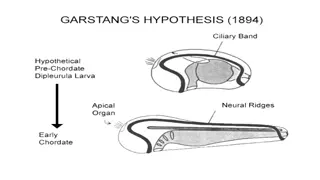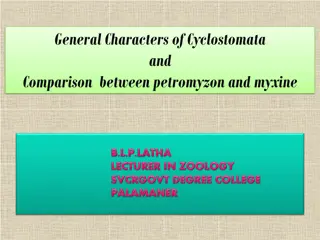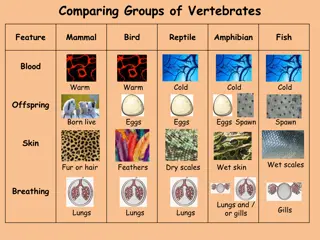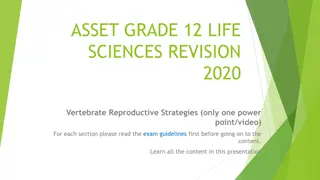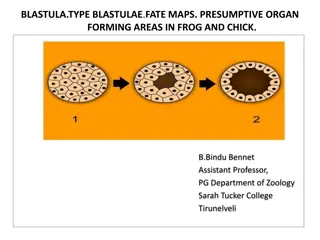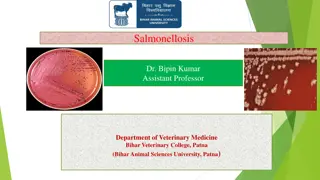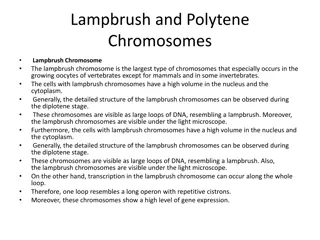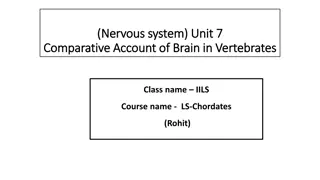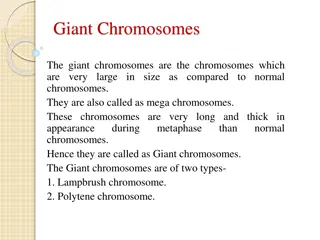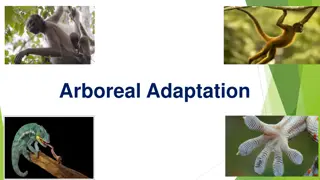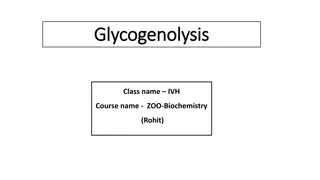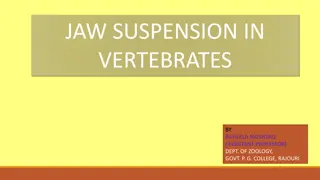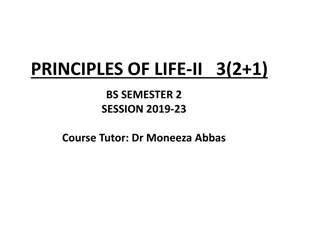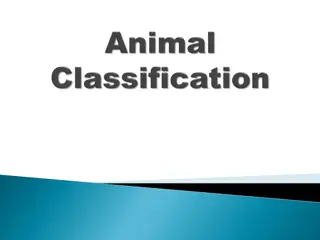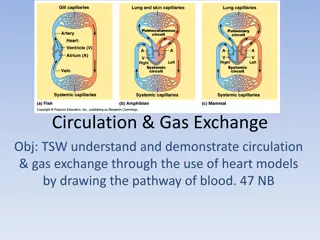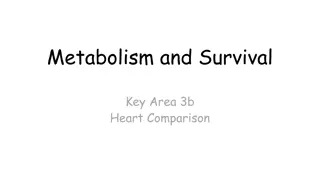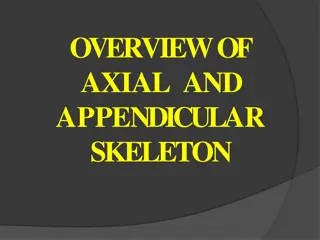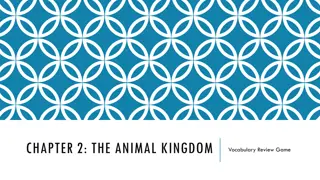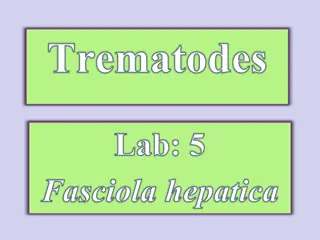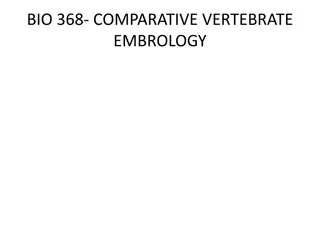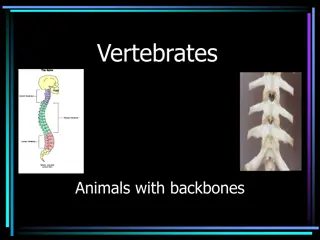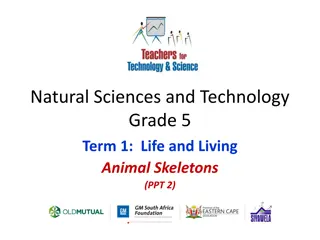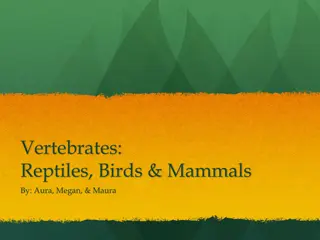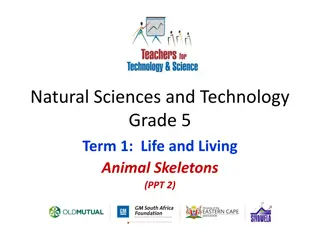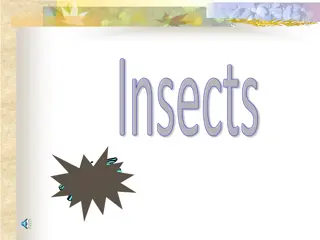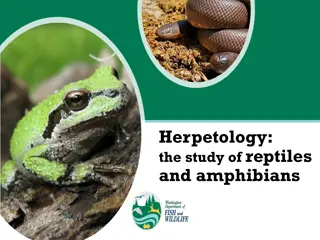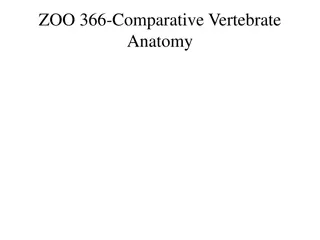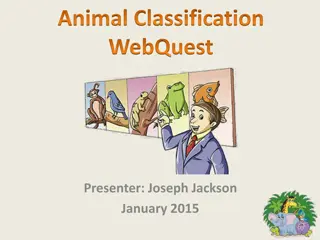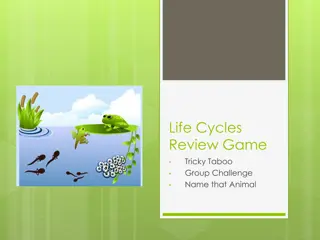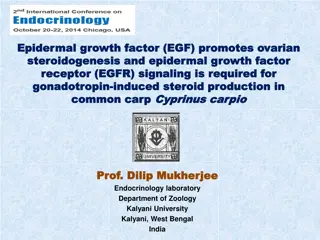The Fascinating World of Fishes: A Comprehensive Overview
Fishes, the most numerous vertebrates on Earth, exhibit incredible diversity across various groups such as Agnatha, Chondrichthyes, and Osteichthyes. From jawless Agnatha like lampreys to bony Osteichthyes including lobe-finned and ray-finned species, fishes display unique characteristics and adapta
6 views • 8 slides
Overview of Agnatha: Jawless Fish in Chordata
Agnatha, the superclass of jawless fish in the phylum Chordata, includes both present (cyclostomes) and extinct species. Cyclostomes, such as lampreys and hagfishes, lack jaws and have unique adaptations. They have primitive characteristics like a circular mouth and lack of paired fins, alongside sp
1 views • 15 slides
General Characters and Comparison of Cyclostomata: Petromyzon vs. Myxine
Cyclostomata, a group of jawless vertebrates, comprises hagfishes and lampreys, exhibiting unique characteristics such as cylindrical body, lack of pair fins, smooth skin, and presence of mucous glands. They possess specific features like circular mouth with teeth, lateral line sense organ, and two-
0 views • 8 slides
Comparing Groups of Vertebrates: Features and Differences
Explore the key characteristics of five groups of vertebrates - mammals, birds, reptiles, amphibians, and fish - including details on blood type, offspring, skin, and breathing apparatus. Learn about the unique traits that distinguish these vertebrate groups from one another.
0 views • 4 slides
Vertebrate Reproductive Strategies and Success Factors
Vertebrates exhibit various reproductive strategies to ensure reproductive success, such as external and internal fertilisation, ovipary, vivipary, and ovovivipary. The ultimate goal of each species is to maximize the number of surviving offspring while conserving energy. Different terminologies rel
1 views • 10 slides
Importance of Transport System in Animals for Oxygen Supply
Animals require a transport system to meet tissue oxygen demands efficiently. The size limit for oxygen diffusion alone is around 1 mm due to the proportional increase in radius and diffusion properties. Blood is crucial for transporting oxygen, nutrients, waste products, cells, and heat, as well as
0 views • 17 slides
Types of Blastulae and Their Formation in Frog and Chick Embryos
The development of blastula, an important stage in embryonic development, gives rise to various types such as coeloblastula, discoblastula, and blastocyst in different animal species. In frogs and birds, varied forms of blastulae are observed based on the amount of yolk present, leading to distinct
1 views • 21 slides
Exoskeletons: Structure, Function, and Diversity
Exoskeletons are rigid coverings that support and protect the bodies of various animals, serving vital roles in structure, defense, and movement. They vary in composition, such as chitin in arthropods and bone in vertebrates like turtles. This comprehensive overview explores the significance, types,
0 views • 4 slides
Salmonellosis: Causes, Clinical Presentations, and Transmission
Salmonellosis is caused by the gram-negative bacterium Salmonella enterica. It predominantly affects warm-blooded vertebrates, leading to carrier states, septicemia, enteritis, and other clinical presentations like abortion and arthritis. The disease is transmitted through contaminated foods of anim
0 views • 15 slides
Lampbrush and Polytene Chromosomes: Structures and Functions
Lampbrush chromosomes, found in growing oocytes of vertebrates, display large loops of DNA during the diplotene stage, with high gene expression levels. Polytene chromosomes, giant interphase chromosomes in insects, contain multiple strands with distinct banding patterns. Chromocenter serves as the
0 views • 14 slides
Comparative Analysis of Vertebrate Brains: From Cartilaginous Fish to Amphibians
The brain in vertebrates varies in size and complexity, with distinct structures like the prosencephalon and mesencephalon. From cartilaginous fishes with large olfactory lobes to bony fishes with specialized brains, the evolution of brain structures can be observed. Amphibians, like frogs, show uni
1 views • 12 slides
Giant Chromosomes: Lampbrush and Polytene Chromosomes
Giant chromosomes, such as lampbrush and polytene chromosomes, are significantly larger in size compared to normal chromosomes. Lampbrush chromosomes are found in oocytes of various vertebrates, while polytene chromosomes are common in dipteran flies like Drosophila. These specialized chromosomes pl
3 views • 10 slides
Arboreal Adaptation in Animals
Arboreal locomotion refers to the movement through trees exhibited by animals like squirrels, sloths, and monkeys. These animals possess physical adaptations such as long limbs, prehensile tails, and claws to aid in tree climbing. Arboreal life offers safety, retreat, and easy access to food, shapin
0 views • 14 slides
Aquatic Adaptation in Animals
Aquatic adaptation refers to the changes in an animal's body organization to thrive in a water habitat. Vertebrates have evolved to lead partial or total aquatic lives, showcasing various adaptations. Water as a habitat offers a homogenous medium, stable conditions, and rich food resources. Aquatic
1 views • 9 slides
Glycogenolysis in Vertebrates: A Detailed Overview
In vertebrates, glycogen serves as a glucose reservoir in the liver and skeletal muscles. Glycogenolysis is the breakdown of glycogen into glucose-6-phosphate, crucial for providing glucose to tissues in the absence of dietary sources. Enzymes like glycogen phosphorylase, debranching enzyme, and pho
1 views • 13 slides
Jaw Suspension in Vertebrates: Types and Mechanisms Explored
Jaw suspension in vertebrates involves the attachment of the lower jaw to the upper jaw or skull for efficient biting and chewing. Different types of jaw suspensions exist, such as holostylic and autosystylic, each based on modifications in visceral arches. Holostylic suspension involves the lower j
0 views • 10 slides
Vertebrates Final Review - Study Guide with Images
Explore the world of vertebrates with this comprehensive final review. Learn about chordates, fish, amphibians, reptiles, birds, and mammals through informative images and questions. Test your knowledge on topics like excretion, respiratory organs, locomotion, and anatomical features unique to chord
0 views • 74 slides
Unicellular and Multicellular Organisms in Biology
Explore the basic differences between unicellular and multicellular organisms, including the distinctions between prokaryotes and eukaryotes. Unicellular organisms, such as bacteria and amoeba, consist of a single cell and are often microscopic. Examples of both prokaryotic and eukaryotic unicellula
0 views • 10 slides
The Classification of Living Organisms
Living organisms are classified into five kingdoms, each further divided into smaller groups called phyla, classes, orders, and genus. The five kingdoms are Monera, Fungi, Protista, Plantae, and Animalia. Animals are categorized into invertebrates and vertebrates, with significant agricultural impor
0 views • 50 slides
Circulation and Gas Exchange in Living Organisms
Explore the diverse circulatory systems in invertebrates and vertebrates, from jellyfish to humans. Learn about open and closed circulatory systems, the structure and function of the heart, heart valves and sounds, as well as how heart rate and cardiac output are measured.
0 views • 11 slides
Vertebrate Circulatory Systems
Vertebrates have closed circulatory systems with efficient mechanisms for oxygen delivery through cardiovascular systems. Fish have a single circulatory system with a two-chambered heart, while other organisms utilize double circulatory systems for more efficient blood flow to both lungs and body ti
0 views • 16 slides
Environmental Risk Assessment of Australian Marsupials and Native Rodents
Explore the challenges and solutions in conducting environmental risk assessments for terrestrial vertebrates like marsupials, native rodents, and birds in Australia. Dive into topics such as exposure calculations, toxicity evaluations, and data gaps that influence decision-making processes. Gain in
0 views • 45 slides
The Axial and Appendicular Skeleton in Vertebrates
The axial skeleton consists of the bones in the head and trunk, while the appendicular skeleton supports the limbs in vertebrates. The appendicular skeleton aids in locomotion and manipulation, comprising 126 bones in total. Understanding the structure and functions of these skeletal systems is vita
1 views • 23 slides
Animal Kingdom Vocabulary Review Game
Test your knowledge of the animal kingdom with this vocabulary review game. Answer questions about invertebrates, vertebrates, and different types of animals to earn points for your team. Stay sharp to win classroom cash!
0 views • 32 slides
Overview of Fasciola hepatica Life Cycle
Explore the life cycle of Fasciola hepatica, a parasitic trematode infecting humans and other vertebrates. Learn about its various stages including adult worms, eggs, miracidium, cercaria, and metacercaria. Understand the intricate reproductive processes involving both sexual and asexual reproductio
0 views • 13 slides
Spiruridae and Filariidae Nematodes in Vertebrates
Spiruridae and Filariidae are families of parasitic nematode worms affecting vertebrates and insects. This article delves into the characteristics, hosts, geographical distribution, biology, and control measures of Spiruridae, focusing on Spirura rytipleurites, and Filariidae, highlighting Dirofilar
0 views • 14 slides
Vertebrate Embryology Through Evolutionary Development
Explore the fascinating world of comparative vertebrate embryology, examining how the development of an individual reflects its evolutionary journey. Delve into the principle of Ontogeny Recapitulates Phylogeny, common developmental plans, and the historic contributions of renowned embryologists lik
0 views • 17 slides
Exploring Vertebrates: Skeletons and X-rays
Dive into the world of vertebrates with a detailed exploration of their skeletons and X-rays. Discover the fascinating structures of frogs, snakes, lizards, birds, fish, humans, bats, dogs, dolphins, and even dinosaur fossils. Explore the intricate details through a series of captivating images, she
0 views • 18 slides
Animal Skeletons in Grade 5 Natural Sciences and Technology
Explore the fascinating world of animal skeletons in Grade 5 Natural Sciences and Technology. Learn about the differences between vertebrate and invertebrate skeletons, the importance of skeletons in animal movement, and the various types of skeletons found in nature. Discover how vertebrates' skele
0 views • 11 slides
Exploring Vertebrates: Reptiles, Birds, and Mammals
Delve into the world of vertebrates, including reptiles, birds, and mammals. Discover the unique characteristics and adaptations of each group, from the scales of reptiles to the feathers of birds and the live birth of mammals. Explore how these creatures have evolved to thrive in their environments
0 views • 6 slides
Animal Skeletons in Grade 5 Natural Sciences and Technology
Exploring the diverse world of animal skeletons, this Grade 5 Natural Sciences and Technology presentation covers vertebrates and invertebrates, showcasing different types of skeletons like endoskeletons and hydroskeletons. Understand the importance of skeletons in supporting movement and protecting
0 views • 11 slides
The Fascinating World of Insects and Animal Classification
Discover the unique characteristics of insects such as their body parts, legs, compound eyes, antenna, and exoskeleton. Learn about the classification of animals into insects and non-insects, as well as vertebrates and invertebrates. Explore how animals can be sorted based on different criteria and
0 views • 35 slides
Rainforest Animals through Classification and Comparison
Dive into the world of rainforest animals by learning their names, categorizing them into vertebrates and invertebrates, describing their characteristics, creating animal profiles, and comparing their different traits. Develop language skills by expressing opinions, classifying animals, and writing
0 views • 6 slides
Herpetology: Reptiles, Amphibians, and Their Fascinating World
Delve into the captivating realm of herpetology, the study of reptiles and amphibians. Discover the characteristics of these cold-blooded vertebrates, from scaly reptiles to slimy amphibians. Uncover the similarities and differences between these two groups, their reliance on water, and the rich div
0 views • 22 slides
Comparative Vertebrate Anatomy - Alimentary System Overview
The alimentary system in vertebrates undergoes invagination to form a stomodeum and proctodeum, with tissue of mesodermal origin forming the wall of the alimentary canal. Differentiated into regions, the canal includes the buccal cavity, pharynx, esophagus, stomach, and intestine. The system is cruc
0 views • 93 slides
Animal Classification WebQuest: Dive into the World of Vertebrates!
Discover the fascinating world of animal classification with the Animal Classification WebQuest presented by Joseph Jackson. Learn about the five categories of vertebrates - mammals, reptiles, birds, fish, and amphibians. Dive into tasks like identifying animals, completing worksheets, playing games
0 views • 12 slides
Animal Life Cycles Review and Group Challenge
Explore the world of animal life cycles through a trivia game and group challenge. Test your knowledge on organisms, embryos, vertebrates, invertebrates, and more. Dive into rounds of tricky taboo questions and identify adult animals from their offspring. Discover common traits among mammals, unders
0 views • 8 slides
Concept of Rewilding: A Historical Perspective
Rewilding, defined as returning land to a wilder and more natural state, has roots in the early 1990s with a focus on reintroducing large carnivores into North America. Various scholars have different perspectives on rewilding, emphasizing the restoration of big wilderness, regulatory roles of large
0 views • 42 slides
Epidermal Growth Factor in Ovarian Steroidogenesis
The function of Epidermal Growth Factor (EGF) in promoting ovarian steroidogenesis and signaling pathways induced by gonadotropins, essential for understanding its role in the process. Studies have shown EGF's impact on steroid production in common carp and its influence on granulosa cell differenti
0 views • 28 slides

